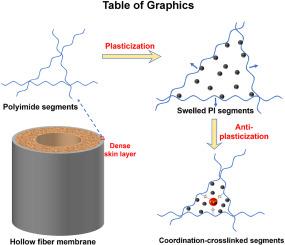通过金属离子配位增强中空纤维膜的抗塑化能力,实现先进的氦回收
IF 8.4
1区 工程技术
Q1 ENGINEERING, CHEMICAL
引用次数: 0
摘要
塑化会严重影响气体分离膜的气体分离性能,尤其是具有超薄表皮层的中空纤维膜(HFM)。虽然传统的热交联是解决这一问题的有效方法,但它往往会导致中空纤维膜过渡层塌陷,从而导致气体渗透率显著下降。在此,我们使用含羧基的 6FDA-mPDA0.65-DABA0.3-TFMB0.05 共聚亚胺,通过金属离子配位,制造出了聚酰亚胺-铈(PI-Ce)复合高频膜,从而实现了抗塑化的天然气氦气回收。我们优化了掺杂成分和纺丝条件,生产出了表皮层薄至 300 纳米的无缺陷中空纤维膜。我们使用傅立叶变换红外光谱(FTIR)和扩展 X 射线吸收精细结构(EXAFS)光谱对羧基和铈离子之间的配位进行了表征。与原始高频膜相比,聚合物-金属配位膜具有更高的气体选择性,这是由于聚合物-金属配位实现了量身定制的微孔。此外,PI-Ce 高频膜的混合气体 He/CH4 选择性仅下降了 10.8%,明显低于原始高频膜在含二氧化碳进料压力低于 400 PSIA 时的 55.4%。分子动力学模拟证实,配位限制了分子链的膨胀,从而抑制了二氧化碳引起的塑化。PI-Ce 复合物 HFMs 卓越的抗塑化能力为从侵蚀性天然气环境中回收氦气提供了一种新策略。本文章由计算机程序翻译,如有差异,请以英文原文为准。

Enhanced plasticization resistance of hollow fiber membranes via metal ion coordination for advanced helium recovery
Plasticization can significantly impair the gas separation performance of gas separation membranes, especially for hollow fiber membranes (HFMs) with ultrathin skin layer. While conventional thermal crosslinking is an effective method to address this issue, it often leads to the transition layer collapse in HFMs, resulting in a significant decrease in gas permeance. Herein, we fabricate polyimide-cerium (PI–Ce) complex HFMs using a carboxylic group-containing 6FDA-mPDA0.65-DABA0.3-TFMB0.05 copolyimide through metal ion coordination to achieve plasticization-resistance helium recovery from natural gas. We optimized dope compositions and spinning conditions to produce defect-free hollow fiber membranes with a skin layer as thin as 300 nm. The coordination between carboxyl groups and cerium ions was characterized using Fourier Transform Infrared Spectroscopy (FTIR) and Extended X-ray Absorption Fine Structure (EXAFS) spectroscopy. The polymer-metal coordinated membranes exhibited enhanced gas selectivities compared to the pristine HFMs due to the tailored microporosity achieved through polymer-metal coordination. Furthermore, the PI-Ce HFMs demonstrated only a 10.8 % decline in mixed-gas He/CH4 selectivity, which is significantly lower than the 55.4 % decline observed in pristine HFMs when exposed to CO2-containing feed pressures below 400 PSIA. Molecular dynamics simulations confirmed that coordination confined molecular chain swelling, thereby suppressing plasticization caused by CO2. The exceptional plasticization resistance of the PI-Ce complex HFMs provides a novel strategy for recovering helium from aggressive natural gas environments.
求助全文
通过发布文献求助,成功后即可免费获取论文全文。
去求助
来源期刊

Journal of Membrane Science
工程技术-高分子科学
CiteScore
17.10
自引率
17.90%
发文量
1031
审稿时长
2.5 months
期刊介绍:
The Journal of Membrane Science is a publication that focuses on membrane systems and is aimed at academic and industrial chemists, chemical engineers, materials scientists, and membranologists. It publishes original research and reviews on various aspects of membrane transport, membrane formation/structure, fouling, module/process design, and processes/applications. The journal primarily focuses on the structure, function, and performance of non-biological membranes but also includes papers that relate to biological membranes. The Journal of Membrane Science publishes Full Text Papers, State-of-the-Art Reviews, Letters to the Editor, and Perspectives.
 求助内容:
求助内容: 应助结果提醒方式:
应助结果提醒方式:


